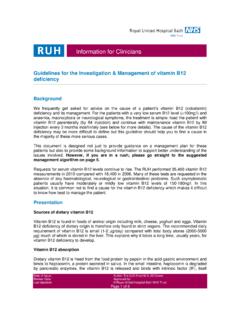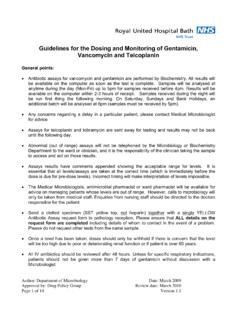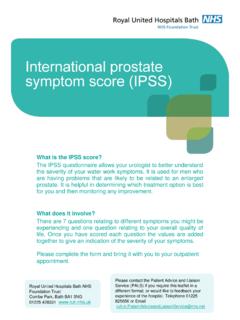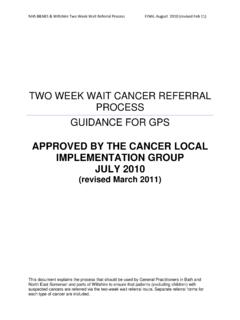Transcription of VITAMIN D DEFICIENCY IN ADULTS - Royal United Hospital
1 Department of Clinical Biochemistry Information for Clinicians VITAMIN D DEFICIENCY IN ADULTS . TS. Background VITAMIN D (calciferol) is the collective name for a group of related steroid-like molecules, which includes VITAMIN D2 (ergocalciferol) and VITAMIN D3 (cholecalciferol). It is a fat soluble VITAMIN and is stored in liver and adipose tissue. VITAMIN D regulates the absorption of calcium and phosphate, and is essential for skeletal growth and bone health. It also has several non-skeletal roles in the body, such as regulating cell proliferation and differentiation and maintaining a healthy immune system.
2 Around 20% ADULTS may have low VITAMIN D status. Severe DEFICIENCY of VITAMIN D can result in rickets in children and osteomalacia in ADULTS . The principle source of VITAMIN D for humans is from synthesis in the skin following exposure to UV light. In the northern hemisphere, the intensity of sunlight required to generate VITAMIN D in this way is only present during the summer months. Dietary VITAMIN D is available in foods such as oily fish, cod liver oil, red meat, fortified cereals, fortified margarine/spreads and egg yolks. In the UK, milk is not fortified with VITAMIN D, so dairy products contain only small amounts of VITAMIN D.
3 The biologically active form of VITAMIN D is synthesised in the body by hydroxylation in the liver, and then the kidneys, to make 1,25-dihydroxyvitamin D (calcitriol). Routine laboratory testing measures 25-hydroxyvitamin D, which is the most stable form of the VITAMIN circulating in the plasma, and reflects both cutaneous synthesis and dietary intake. Risk factors for VITAMIN D DEFICIENCY Table 1 summarises the main risk factors for VITAMIN D DEFICIENCY in the UK population1: Ref.: PATH 023 Version: 1. Approved by: Dr Moya O'Doherty, Consultant Chemical Pathologist Approved on: 28 May 2021.
4 Author: Beverley Harris, Consultant Clinical Scientist Review date: 28 May 2024. Date of Issue: 28 May 2021 Page 1 of 7. Royal United Hospitals Bath NHS Foundation Trust Table 1: Risk factors for VITAMIN D DEFICIENCY Inadequate UVB light Inadequate dietary Metabolic factors exposure intake or absorption Pigmented skin (non-white Vegetarian/vegan (or other People aged 65 years (reduced synthesis ethnicity) fish-free diet) in the skin). Lack of sunlight exposure or Malabsorption ( Pregnant/breastfeeding women atmospheric pollution coeliac disease, cystic fibrosis, Crohn's disease Drug interactions, rifampicin, Latitude etc.)
5 Anticonvulsants (carbamazepine, oxcarbazepine, phenobarbital, phenytoin, Skin concealing garments or Short bowel syndrome primidone, valproate), isoniazid, routine use of sun protection cholestyramine, sucralfate, glucocorticoids, factor 15 or above Cholestatic liver disease, highly active antiretroviral treatment jaundice (HAART). Housebound or indoor living ( care homes) Chronic liver disease Seasonal Chronic kidney disease Nephrotic syndrome Prevention of VITAMIN D DEFICIENCY /insufficiency The Scientific Advisory Committee on Nutrition (SACN) report on VITAMIN D and Health2 and NICE.
6 Clinical Knowledge Summary (2018)3 recommend the following for the UK population to prevent VITAMIN D DEFICIENCY /insufficiency: People in higher risk groups (see Table 1) are advised to take a daily supplement of 400 IU (10 g) VITAMIN D throughout the year. In winter months (October to early March), ALL ADULTS (and children >4 years old) should consider taking a daily supplement of 400 IU (10 g) VITAMIN D. In summer months, the majority of the population will get enough VITAMIN D through exposure to sunlight and a healthy, balanced diet. NOTE: Supplements are widely available as over the counter preparations and SHOULD NOT.
7 Be prescribed. Ref.: PATH 023 Version: 1. Approved by: Dr Moya O'Doherty, Consultant Chemical Pathologist Approved on: 28 May 2021. Author: Beverley Harris, Consultant Clinical Scientist Review date: 28 May 2024. Date of Issue: 28 May 2021 Page 2 of 7. Royal United Hospitals Bath NHS Foundation Trust VITAMIN D and COVID-19. In December 2020, in response to the global pandemic, NICE published a rapid guideline4 on the use of VITAMIN D supplements to either prevent or treat COVID-19. While acknowledging there is insufficient evidence at present to advocate use of supplements for this purpose, the panel strongly reiterated current UK government advice regarding year round supplementation in high risk groups and in the whole population over the age of 4 years old during the winter months.
8 This is considered to be particularly important during the pandemic because people have been confined indoors more than usual during the spring and summer months5. VITAMIN D supplements should not be offered solely to prevent or treat COVID-19, except as part of a clinical trial. When should VITAMIN D be measured? Routine testing for VITAMIN D DEFICIENCY is NOT necessary. VITAMIN D (25-hydroxyvitamin D) measurement is only indicated: for patients with diseases with outcomes that may be improved with VITAMIN D treatment, confirmed osteomalacia, osteoporosis.
9 (NB: measurement is not necessary if patient is co- prescribed VITAMIN D with their anti-resorptive treatment). for patients with symptoms that could be attributed to VITAMIN D DEFICIENCY , suspected osteomalacia, chronic widespread pain with other features of osteomalacia before starting patients on a potent antiresorptive agent (zoledronate, denosumab, teripardatide)6. See Figure 1 for a summary of the guidance from the Royal Osteoporosis Society ( VITAMIN D and Bone Health: a practical clinical guideline for patient management, 2018).6. Ref.: PATH 023 Version: 1.
10 Approved by: Dr Moya O'Doherty, Consultant Chemical Pathologist Approved on: 28 May 2021. Author: Beverley Harris, Consultant Clinical Scientist Review date: 28 May 2024. Date of Issue: 28 May 2021 Page 3 of 7. Royal United Hospitals Bath NHS Foundation Trust Figure 1: When should VITAMIN D be measured? No risk factors for Risk factors* for Known disease Symptoms# that could Starting anti- DEFICIENCY , DEFICIENCY , where VITAMIN D be attributed to resorptive agent, symptom free symptom free treatment improves VITAMIN D DEFICIENCY , zoledronate, outcomes, suspected denousmab, confirmed osteomalacia, chronic teriparatide osteomalacia widespread pain DO NOT MEASURE VITAMIN D CHECK VITAMIN D STATUS.









